
Sexual Reproduction in Flowering Plants: Sexual reproduction is the formation of a new organism through the fusion of gametes or sex cells from both parents. Plants have both male and female sex organs, which help to form seeds when their gametes combine. These seeds germinate and produce new plants when the conditions are right. Flowering plants, or angiosperms, primarily reproduce sexually.
Reproduction in these plants revolves around the flower, which contains both male and female gametes. While all parts of the flower participate in the reproductive process, some may be sterile. Plants reproduce asexually and sexually, using propagules such as leaves, roots, and stems to spread. However, the flower is still the primary reproductive organ for sexual reproduction. The article provides detailed insights into an important chapter of NCERT, which focuses on sexual reproduction in flowering plants.
NEET Exam notes on Sexual reproduction in flowering plants have been prepared by Physics Wallah experts in accordance with the updated NEET and CBSE syllabuses, with the goal of assisting students in properly preparing for their exams.
Also Check:
- NEET Biology Notes
- NEET Biology Chapter wise Weightage
- NEET Biology Important Questions with Answers
Sexual Reproduction in Flowering Plants- Structure of Flower
Flowers play many roles in human culture, representing beauty, social expression, religious devotion, and cultural identity. They have traditionally conveyed profound human emotions such as love, grief, happiness, and affection, which add depth to various rituals and ceremonies. A complete flower comprises two distinct sections:
- Vegetative Part
- Reproductive Part
The vegetative part consists of the following components:
Petals: Petals, or corollas, are brightly colored structures that attract pollinators like bees, insects, and birds.
Sepals: Sepals, also known as the calyx, are green-colored segments beneath the petals. Their primary function is to shield developing buds.
The reproductive segment of a flower includes:
Stamen: The male reproductive organ, or the Androecium, comprises two main parts: the anther and filaments.
Pistil: The innermost portion and the female reproductive organ of a flower, consists of three integral parts: stigma, style, and ovary. This ensemble is collectively referred to as the Gynoecium. 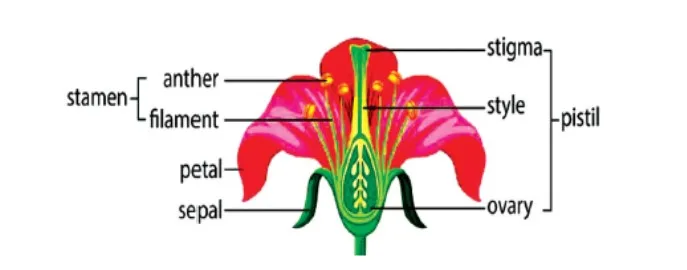 NOTE: Sexual Reproduction in Flowering Plants is an important topic on the NEET Exam. Sexual reproduction in flowering plants NEET Biology revision notes cover all topics that are important in the exams.
NOTE: Sexual Reproduction in Flowering Plants is an important topic on the NEET Exam. Sexual reproduction in flowering plants NEET Biology revision notes cover all topics that are important in the exams.
Sexual Reproduction in Flowering Plants- Fertilization Events
Several morphological and endocrine changes occur during flower formation, resulting in the modification of the floral primordium and the organization of its various whorls. Sexual reproduction in flowering plants is divided into distinct stages:
- Pre-Fertilization: Structures and Events
- Fertilization Event
- Post-Fertilization: Structures and Events
Sexual Reproduction in Flowering Plants Important Questions for NEET
Pre Fertilization- Structures and Events
Before fertilization, several events occur to prepare the flower for reproduction:
1. Structure of Stamen
This refers to the flower's male reproductive organ, which consists of the filament and the anther. The stamen is composed of two primary components:
Filament: This elongated structure serves as the sterile part of the stamen, linking the anther to the thalamus or petals of the flower.
Anther: This is the fertile part of the stamen where pollen grains are formed. Typically bilobed, the anther contains two thecae in each lobe, making it dithecous. Each theca houses two microsporangia, resulting in four microsporangia within a typical angiosperm anther. Each microsporangium develops into a pollen sac, producing numerous microspores known as pollen grains.
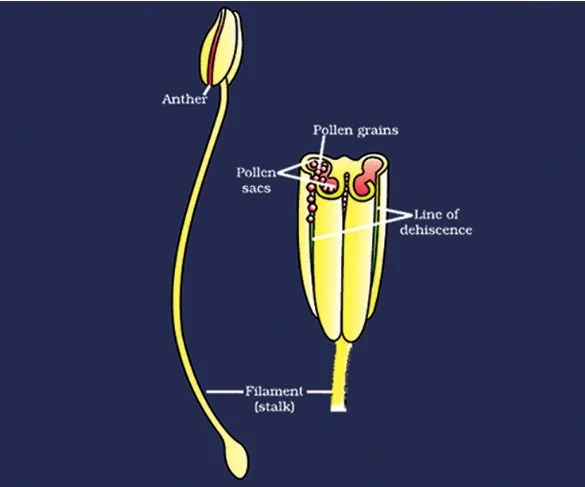
2. Anther Development
The anther undergoes development to produce pollen grains, which contain the male gametes. The anther possesses parenchyma tissue. Hypodermal archesporial cells are developed, one in each corner. Each archesporial cell undergoes a periclinal division to produce an outer primary parietal cell and an inner primary sporogenous cell. The primary parietal cell divides to create a 3-5 layered anther wall. The inner layer of anther is tapetum that provides nutrition The outer three layers provide protection and aid in anther dehiscence:
- Epidermis
- Endothecium
- Middle layer
3. Development of the Microspore or Microsporogenesis
This process involves the formation of microspores within the pollen sacs of the anther. During anther development, each sporogenous cell, also known as the microspore mother cell or the pollen mother cell, divides meiotically, resulting in microspore tetrads, which are groups of four cells. Each cell in the sporogenous tissue can generate a microspore tetrad. When viewed in transverse section, a standard microsporangium appears circular. It is typically surrounded by four layers of walls: epidermis, endothecium, middle layers, and tapetum.
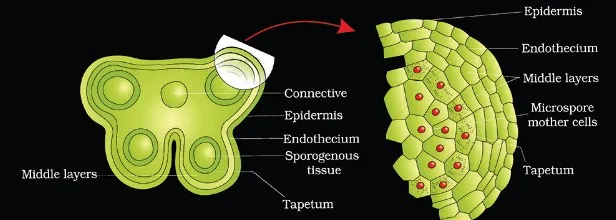
4. Structure of the Pollen Grain
The pollen grain is the male gametophyte of seed plants, containing the male reproductive cells. It is made up of two layers: the inner layer (intine) and the outer layer (exine). The intine is primarily pectin and cellulose, whereas the exine is sporopollenin, a highly durable substance. Sporopollenin is resistant to physical and biological degradation, allowing pollen grains to be preserved for long periods of time and aiding taxonomical studies as fossils.
The exine has various sculpturing patterns that help to identify plant families, genera, and species. The pollen grain's surface contains germ pores not covered by an exine layer. During pollination, the pollen tube emerges from the germ pore.
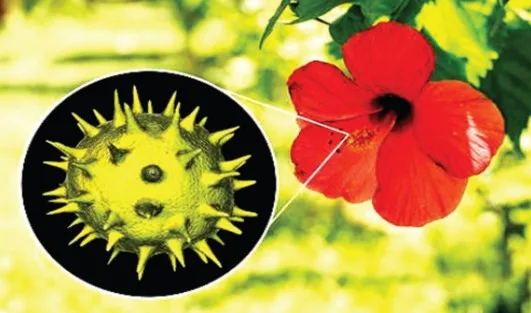
5. Structure of the Gynoecium
The gynoecium, representing the female reproductive structure of the flower and occupying the terminal whorl, comprises the pistil and is centrally positioned within the thalamus. The pistil encompasses three primary components: the stigma, style, and ovary. The ovary, located at the base, generates ovules internally, which undergo meiosis to yield megaspores, forming female gametophytes and subsequent egg cells. Each pistil consists of:
- Stigma: Serving as a landing site for pollen grains.
- Style: A slender, elongated structure situated beneath the stigma.
- Ovary: The basal, swollen portion of the pistil.
Contained within the ovary is the ovarian cavity, housing the placenta. The placenta gives rise to megasporangia, commonly referred to as ovules.
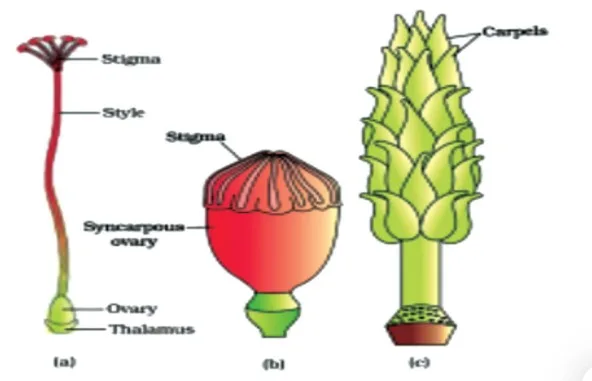
6. Structure of the Ovule
The structure of the ovule is also known as Megasporangium. The ovule is the structure within the ovary of the flower where the female gametophyte develops and fertilization takes place.
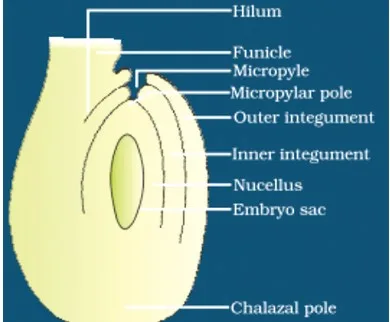
7. Structure of Female Gametophyte (Embryo Sac)
The development of the female gametophyte occurs inside the ovule and typically includes three antipodal cells, one central cell, two synergid cells, and one egg cell. It is often referred to as the embryo sac or megagametophyte.
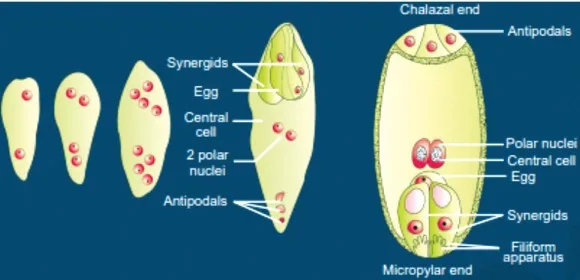
Pollination
Pollination is a vital ecological process essential for the reproduction of all flowering plants. It involves the transfer of mature pollen grains from the anther to the stigma, facilitating sexual reproduction in flowering plants.
There are two main types of pollination:
- Self-Pollination: This occurs when pollen grains from the anther are deposited on the stigma of the same flower or another flower on the same plant.
- Cross-Pollination: This occurs when pollen grains are transferred from the anther of one flower to the stigma of another flower on different plants of the same species.
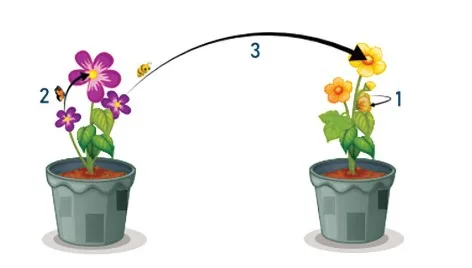
Majority of plants use biotic agents for pollination. Only a small proportion of plants use abiotic agents.
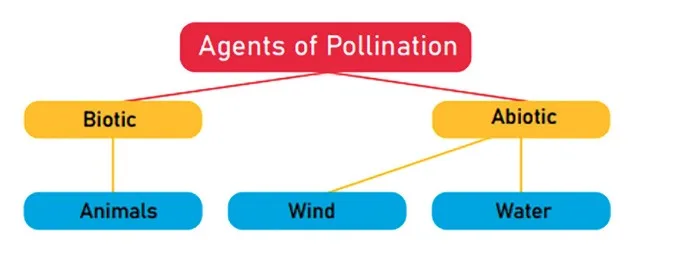
Artificial Hybridization
It is a method employed in crop improvement programs to ensure controlled pollination and prevent unwanted pollen contamination on the stigma:
- Emasculation: This involves the removal of anthers using forceps from flower buds before they open. Emasculation is carried out specifically in bisexual flowers to prevent self-pollination.
- Bagging: Female flowers and emasculated flowers are covered with a suitable-sized bag, typically made of butter paper, to shield the stigma from unwanted pollen contamination.
- Pollination: Once the stigma of the bagged flower becomes receptive, mature pollen grains collected from the anthers of the male parent are carefully dusted onto the stigma.
- Rebagging: Following pollination, the flowers are rebagged to protect them from unwanted pollination, and the seeds or fruits are allowed to develop under controlled conditions.
Pollen Pistil Interaction
Interaction between pollen and pistil involves a recognition process where the pistil determines the compatibility of the pollen. If the pollen is compatible, the pistil accepts it and facilitates the formation of a pollen tube for fertilization. However, if the pollen is incompatible, germination does not occur on the stigma or the pollen tube fails to grow through the style. This recognition process involves a chemical dialogue between the components of the pollen and the pistil, which ultimately determines whether the pollen tube will be accepted or rejected for germination.
Fertilization Event
After pollination, pollen grains travel through the stigma and style before entering the ovary via the pollen tube. Once inside the ovary, one of the male gametes fertilizes the ovule, or female gamete, and the other fuses with the polar nuclei. This fusion produces a zygote, which eventually develops into an embryo. Simultaneously, the second male gamete combines with the polar nuclei, forming the endosperm nucleus that feeds the developing embryo. Finally, fertilization converts the ovules into seeds, and the ovary matures, becoming the fruit.
NEET Previous Year Question Papers
Double Fertilization
Double fertilization, a unique process exclusive to angiosperms, involves two distinct phenomena:
- Syngamy: During this phase, the nucleus of one male gamete merges with the egg nucleus, resulting in fertilization or syngamy. This phenomenon was initially observed by Strasburger in 1884, using Monotropa as a model.
- Triple fusion: In this stage, the second male gamete combines with the two polar nuclei or the secondary nucleus formed by the fusion of the two central cell nuclei. As the second fertilization involves three nuclei in most plants, it is termed triple fusion.
Together, syngamy and triple fusion constitute the broader process known as double fertilization, first elucidated by Nawaschin in 1898.
Syngamy + Triple Fusion = Double Fertilization
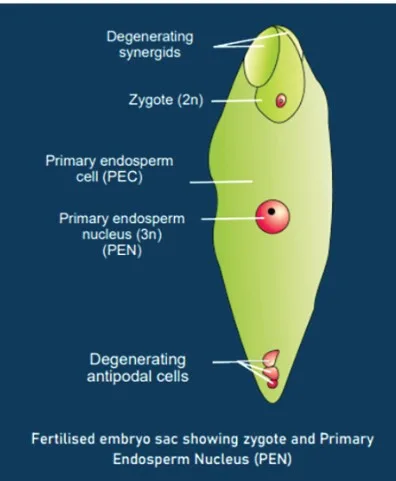
Post-Fertilization- Structures and Events
Post-fertilization events include all of the reproductive processes that occur following fertilization, which results in the formation of a zygote. Following fertilization, the zygote divides to form the embryo, and the endosperm continues to develop.
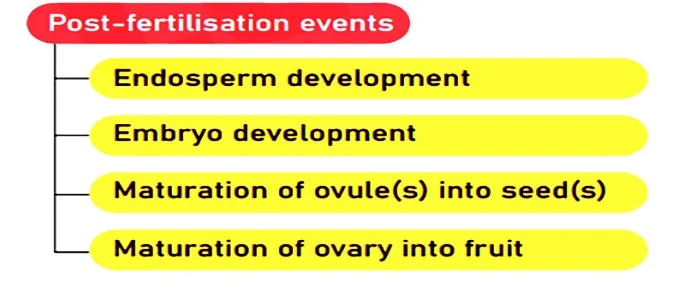
Endosperm Development
The primary endosperm cell undergoes multiple divisions, resulting in the formation of a triploid endosperm tissue. These cells are rich in reserve food materials and serve to nourish the developing embryo. In the typical process of endosperm development, the primary endosperm nucleus undergoes successive nuclear divisions to produce free nuclei, a stage known as free-nuclear endosperm. Subsequently, cell wall formation occurs, transforming the endosperm into a cellular structure. For instance, in a tender coconut, the liquid inside, known as coconut water, consists of free-nuclear endosperm, while the surrounding white kernel represents cellular endosperm.
Endosperm may either be entirely consumed by the developing embryo before seed maturation, as seen in peas, groundnuts, and beans, or it may persist in the mature seed and be utilized during seed germination, as observed in castor beans and coconuts. Endosperm development precedes embryo development as an adaptation to ensure consistent nutrition for the growing embryo.
Embryo Development
The embryo begins its development at the micropylar end of the embryo sac, where the zygote is located. In most cases, zygotes undergo division only after some endosperm has formed, providing nourishment to the developing embryo. Although seeds of monocots and dicots exhibit significant differences, their early embryonic development, known as embryogeny, follows similar patterns.
During embryogeny, the zygote undergoes repeated mitotic divisions and subsequent cell differentiation, leading to the formation of the embryo. The zygote (2n) undergoes division to form the proembryo, which then progresses through stages such as globular, heart-shaped, and eventually matures into the embryo.
Zygote(2n)→embryo(2n)
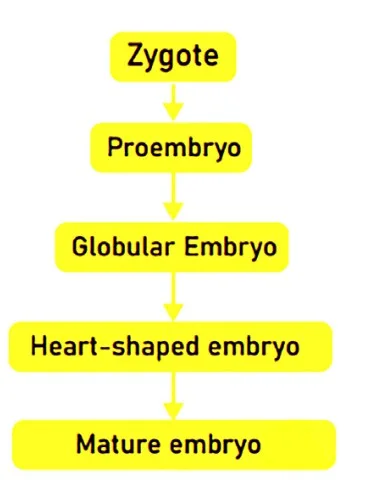
Maturation of Ovules into Seeds
In flowering plants, the seed is the final stage of sexual reproduction and is commonly known as a fertilized ovule. Seeds are enclosed within fruits and typically consist of three major components:
- Seed coat(s)
- Cotyledon(s)
- Embryo axis
The cotyledons of the embryo are usually simple structures, often thickened and swollen due to the storage of food reserves, particularly in legumes. Seeds can be categorized into two main types based on their characteristics:
- Non-albuminous or exalbuminous seeds: These seeds lack residual endosperm as it is entirely consumed during embryo development before seed maturation. Examples include peas, groundnuts, beans, and sunflowers.
- Albuminous seeds: These seeds retain a portion of endosperm as it is not entirely utilized during embryo development. Examples of albuminous seeds include wheat, maize, castor, barley, rice, and coconut.
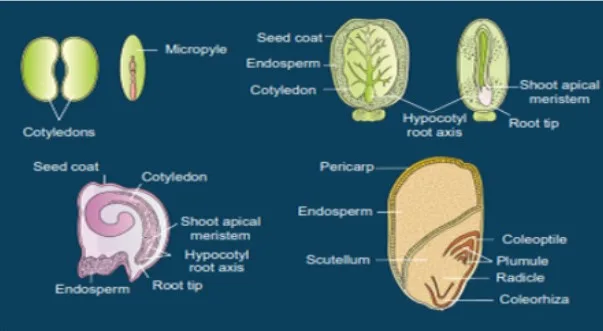
Maturation of Ovary into Fruits
When the ovary of a flower becomes fertilized or ripened, it transforms into a fruit. This transformation occurs simultaneously with the maturation of ovules into seeds. The ovary wall transforms into the fruit wall, known as the pericarp. This process produces two primary types of fruits:
- True fruit: True fruits develop solely from the ovary, with no contribution from other parts of the flower. Examples of true fruits include mangoes and tomatoes.
- False fruit: False fruits form when other flower parts, in addition to the ovary, contribute to fruit formation. Examples of false fruits include strawberries, apples, and cashews, where the fleshy thalamus is consumed.
In fruits, the ovary wall is transformed into the pericarp. Some fruits, known as parthenocarpic fruits , develop without fertilization and therefore do not produce seeds. Examples of parthenocarpic fruits include bananas and citrus fruits. Additionally, certain parthenocarpic fruits are artificially induced through the application of hormones such as auxins and gibberellins.
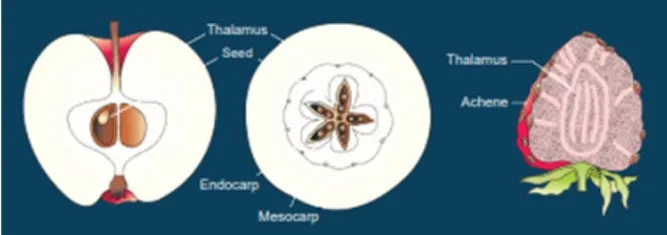
Apomixis
Apomixis is a phenomenon observed in certain flowering plants, such as some species of Asteraceae and grasses, where seeds are produced without fertilization. This process of fruit production without fertilization is termed as apomixis, representing a form of asexual reproduction that imitates sexual reproduction.
Various mechanisms lead to the development of apomictic seeds. In some plants, the diploid egg cell forms directly without undergoing reduction division and matures into an embryo without fertilization. Alternatively, in many species like Citrus and Mango, the ovules may undergo apomixis, forming seeds without fertilization.
Polyembryony
Polyembryony is a phenomenon observed in certain plant species, particularly those with polyembryonic seeds, where more than one embryo develops within a single seed. This occurrence of multiple embryos within a seed is referred to as polyembryony. In plants exhibiting polyembryony, additional embryos develop within the ovule, originating from cells surrounding the embryo sac. This results in multiple embryos within a single seed, providing an interesting aspect of seed development and reproduction in certain plant species.
Learn more about Flowering Plants, Sexual Reproduction in Flowering Plants, by referring to the reproduction in flowering plants notes @PhysicsWallah. Physics Wallah provides the excellent NEET Online Coaching for NEET and CBSE students.
PW offers top-notch NEET Online Coaching with the best faculty and study materials for NEET preparation for class 12th. Early preparation is essential and online coaching plays a vital role in NEET preparation. Check out NEET Online Courses to begin your journey.
Sexual Reproduction in Flowering Plants FAQs
What is the sexual reproduction in flowering plants module?
What is sexual reproduction in flowering plants short notes for NEET?
What is the process of sexual reproduction?
What is an example of sexual reproduction in plants?
What is sexual reproduction in flowering plants Class 12?










